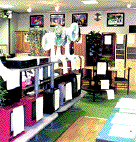 Science & Technology || Search || Back Numbers GREENING WHITE GOODS:
 These recycled appliances are ready to go back to work. (Photo:Tokyo Metropolitan Kyobashi Waste Collection Office) Recycling of large appliances, until now carried out mainly in industry, could be coming closer to home. In the pipeline is legislation to promote recycling of the four main bulky electrical appliances: televisions, refrigerators, washing machines, and air conditioners. When they are ready for throwing out, their manufacturers would have to take them back. The ensuing recycling effort would involve local authorities, electrical-appliance stores, and the consumers themselves. The electrical appliance industry is said to be far behind automaking in recycling. It is hoped that this legislation will spur greater awareness.
Manufacturers, Consumers to Pitch In Manufacturers are also being asked to reduce waste as much as possible, for example, by dismantling the collected appliances and reusing the parts. The ministry stresses that the recycling rate of appliance makers, around 30%, is far behind that of automakers, who are up to nearly 80%. To help close the gap, the upcoming legislation envisages numerical targets for recycling in each product class, and public disclosure of numerical recycling "grades" achieved by each manufacturer. The report has also attracted attention because it spells out how much consumers will have to pay. According to the ministry, the sum is likely to work out to between 3,000 and 11,000 yen (25 and 92 dollars at 120 yen to the dollar) per item, a bit higher than the roughly 1,000- (8-dollar) cost of current professional scrapping. The actual sum and method of collection will vary from product to product and company to company, since manufacturers will have free rein in this area. The levy will be made at the time of collection, not of purchase, so that account can be taken of price fluctuation over the 5-20 year lifespan of consumer durables. Presenting the reckoning at collection time is also seen as a way of dampening replacement demand, helping reduce overall levels of garbage. Reducing the Mountains of Waste The fact that poisonous dioxin is released when scrapped appliances are incinerated has also deepened environmental fears. With an eye on the upcoming legislation, more companies are beginning to cast around for "green" suppliers of parts and base materials. One major player has drawn up a list of 53 chemicals used in its production process and divided them into three categories of harmfulness. It plans to set numerical targets for reduction of the use of these chemicals in its plant from autumn, and is seeking the cooperation of several thousand companies it deals with. It is also looking into using fewer types of plastic for electrical appliances to simplify recycling procedures. In July, another company began setting its own environmental standards and making checklists for subcontracted parts, and plans to have suppliers explicitly commit themselves to meeting such standards when contracts are signed. Grassroots Action In the 23 wards of Tokyo, there are nine recycling centers managed by the city. Set up since 1990, they retrieve and repair usable things from bulky garbage collected and give them away. Items such as boom boxes can draw nearly 200 times as many "applicants" as there are units available. At other Tokyo centers, items are sold at around the cost of repair. Such undertakings aren't likely to develop into serious commercial enterprises, but they do significantly help to raise public awareness of recycling issues.  Edited by Japan Echo Inc. based on domestic Japanese news sources. Articles
presented here are offered for reference purposes and do not necessarily
represent the policy or views of the Japanese Government.
Edited by Japan Echo Inc. based on domestic Japanese news sources. Articles
presented here are offered for reference purposes and do not necessarily
represent the policy or views of the Japanese Government.
|
